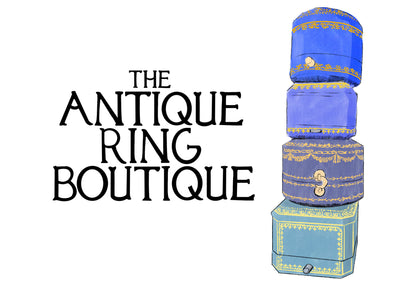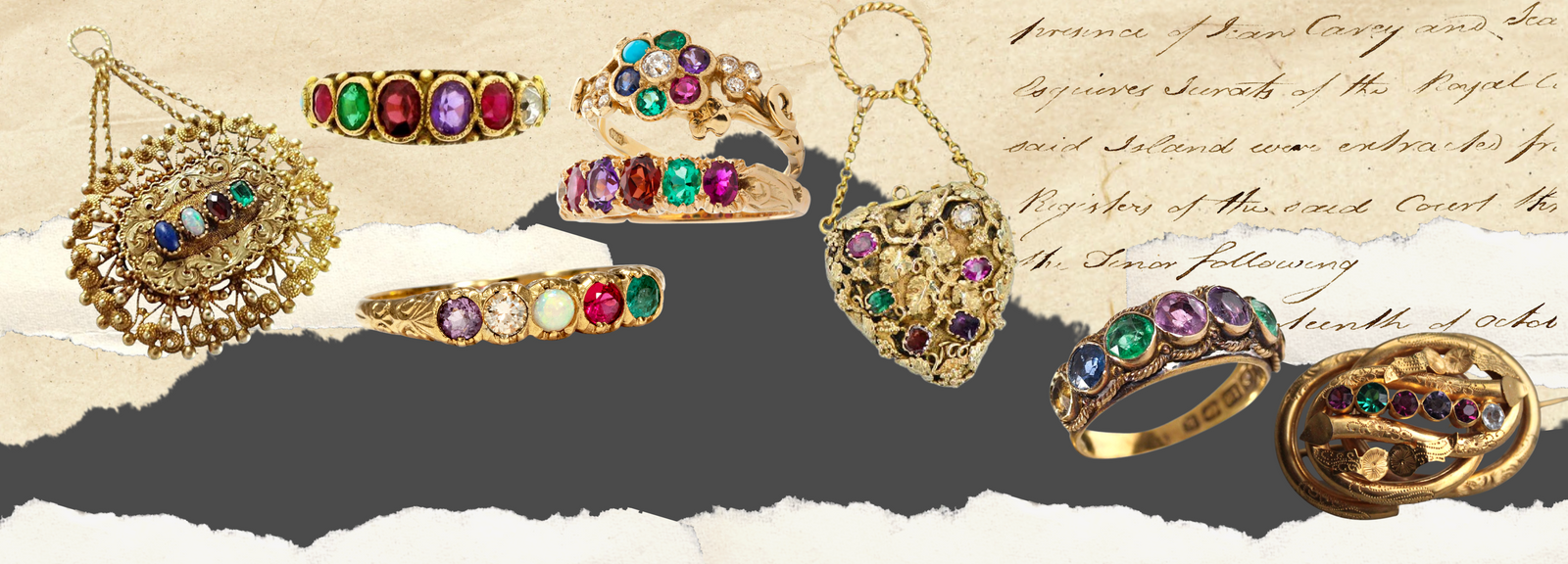Acrostic jewellery originated in the Georgian and Victorian eras and refers to a type of jewellery that has a hidden message within its design. The message is spelt out by the first letter of each gemstone used in the design. This type of jewellery has a rich history and today, it remains a popular and meaningful style of jewellery.
It is believed to have begun with designer Jean-Baptiste Mellerio of the House of Mellerio, a firm favourite of Marie Antoinette. He started with a ring using gems that spelled “J ’adore,” which is “I love” in French. During this time, sending messages through secret codes and hidden meanings grew in popularity. This elusive secret code was necessary and enjoyed by many for a variety reasons. Acrostic jewellery allowed people to personalise their jewellery with hidden meanings and messages. By spelling out a name or word in gemstones, the jewellery became more meaningful and sentimental. It was also often used to convey secret messages or sentiments that were not acceptable to express openly. For example, a lover could spell out their beloved's name in gemstones as a secret declaration of love. It evolved into a most tantalising and exciting practice, that evoked excitement and mischievousness.

After the likes of Queen Victoria and Napoleon Bonaparte began to wear it, acrostic jewellery became fashionable and quickly became a way to display one's wealth and taste. During the Georgian and Victorian eras, jewellery was an important status symbol and a way to display one's social standing. The era was characterised by a fascination with death and mourning, and so acrostic jewellery was often used to commemorate loved ones who passed away in the form of mourning jewellery, with gemstones spelling out the name of a loved one who had passed away or messages such as "In Memory Of" or "Remember Me." This allowed people to keep their loved one's memory close to them and honour their memory. Some of the stones we use now had different names at the time. For example, hessonite garnet used to be referred to as vermeil (which now refers to gold-plated silver) and they would use it as the "V" in “love.” People quickly began to stack acrostic rings, realising this gave them more room to relay a message. Acrostic bracelets and necklaces also became popular for this reason.
 |

|
| Acrostic pendant lockets from Fable & Windsor | 22ct gold Antique 'REGARD' Acrostic Bracelet from Joden Jewellery |
Overall, acrostic jewellery was very popular for its sentimental value, secret messages, fashionability, and ability to commemorate loved ones. The hidden meanings and messages made the jewellery more personal and meaningful, which was especially important during an era when emotions and personal expression were often suppressed. Throughout history, many influential people have worn acrostic jewellery. One of the most famous wearers was Queen Victoria. She wore a bracelet that spelt out the name of her husband, Albert, in gemstones. This was a way for her to keep his memory close to her.Some of the earliest acrostic bracelets were created during the Napoleonic era by French jewellery house Chaumet, as gifts for Empress Josephine and Empress Marie-Louise. Napoleon famously gifted his second wife, Marie Louise, a diamond and gemstone acrostic necklace spelling out "L'Aimée" which means "Beloved" in French. Empress Josephine- Napoleon's first wife, often wore pieces spelling out her name or "Amour" which is French for "Love".
 |
 |
| Antique Victorian 'LOVE' ring, similar to those worn throughout history. Image courtesy of Antique Diamond Rings | Empress Josephine's Acrostic Bracelet by Chaumet |
Acrostic jewellery remains a popular style today, and many modern jewellery brands have been inspired by its history and meaning. The personal element behind acrostic messages has proven to be very popular. Countless contemporary jewellery brands now offer the option to create customised acrostic rings to convey a personal sentiment.
 |

|
 |
| Multi Gem 9ct Stacking Band Ring by Elliebelle Jewellery | Coded Whispers 'DREAM' Acrostic Pendant featured on Wolf & Badger | Stone & Strand 'AMOR' acrostic ring |
We love to see historical jewellery trends come full circle and be met with the enthusiasm and curiosity they deserve. Acrostic jewellery has an undeniably rich history that spans centuries. From its origins in the Georgian and Victorian eras to its popularity among modern jewellery brands, acrostic jewellery remains a meaningful and beloved jewellery style. The hidden messages spelt out by the gemstones have been used to convey love, affection, and commemoration throughout history, and will undoubtedly continue to do so for generations to come. Whether worn by royalty, celebrities (Beyonce!), or everyday people, acrostic jewellery is a special and unique and specific way to express oneself through jewellery. Want to decode some jewellery? Use our acrostic alphabet table below.
A |
Alexandrite, Amethyst, Andalusite, Apatite, Aquamarine |
B |
Beryl, Benitoite |
C |
Carnelian, Chalcedony, Chrysoberyl, Citrine |
D |
Diamond, Diopside |
E |
Emerald |
F |
Feldspar, Fluorite |
G |
Garnet |
H |
Hematite, Howlite |
I |
Idocrase, Iolite |
J |
Jadeite, Jasper |
K |
Kunzite, Kyanite |
L |
Labradorite, Lapis Lazuli, Liddicoatite |
M |
Malachite, Maw-Sit-Sit, Moonstone |
N |
Nephrite |
O |
Opal, Onyx |
P |
Peridot, Pearl |
Q |
Quartz |
R |
Ruby, Rhodochrosite |
S |
Sapphire, Spinel |
T |
Tanzanite, Topaz, Tourmaline, Tsavorite, Turquoise |
U |
Uvarovite, Unakite |
V |
Variscite |
W |
Wulfenite |
X |
Xanthite |
Y |
Yttrium Aluminium Garnet |
Z |
Zircon, Zoisite |

